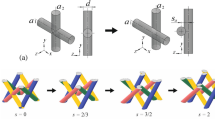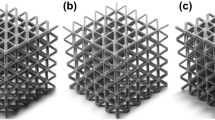Abstract
This work describes the compressive failure behavior and optimization of modified hierarchical re-entrant auxetic metamaterials reinforced with asymmetrical edge cells. The mechanical behavior of these metamaterials is parametrized against the width, thickness and angles of the cells. A Taguchi design (L27 (3^13)) has been performed to determine the effect of the eight geometric factors on the maximum compressive strength (specific strength), mean crushing force (MCF), specific energy absorption (SEA) and Poisson’s ratio of the metamaterials. An analysis of variance (ANOVA) has been also performed to find out the relative significance and contribution percentage of each parameter from a statistical standpoint. The results show that the cell wall angle between the lateral and inclined ribs of the re-entrant unit cells has the largest effect on the compressive strength and absorbed energy of the structure that exhibits a percent variation of 82.5%, 30.0%, 85.9% and 75.1% in specific strength, MCF, SEA and Poisson’s ratio, respectively. Moreover, the size of slot width and thickness, especially in the inclined struts, have a considerable effect on the mechanical performance compared to the angle of asymmetrical cells. Lastly, two samples from the optimization design table showing the best and worst mechanical responses are manufactured by using 3D printing and are tested under compression loading. The effects of the design factors on the deformation mechanisms and mechanical responses have been discussed by comparing the experimental and FE simulation results. The results show that the deformation mechanism of the asymmetrical unit cells and inclined struts play a key role in the resistance of the structures under compressive loads.












Similar content being viewed by others
References
Hu LL, Deng H (2015) Indentation resistance of the re-entrant hexagonal honeycombs with negative poisson’s ratio. Mater Res Innovations 19(sup1):442–445. https://doi.org/10.1179/1432891715Z.0000000001588
Lira C, Scarpa F (2010) Transverse shear stiffness of thickness gradient honeycombs. Compos Sci Technol 70(6):930–936. https://doi.org/10.1016/j.compscitech.2010.02.007
Alderson K, Alderson A, Anand S, Simkins V, Nazare S, Ravirala N (2012) Auxetic warp knit textile structures. Physica Status Solidi (b) 249(7):1322–1329. https://doi.org/10.1002/pssb.201084216
Wang Y, He Q, Chen Y, Gu H, Zhou H (2021) In-plane dynamic crushing of a novel bio-inspired re-entrant honeycomb with negative Poisson’s ratio. J Braz Soc Mech Sci Eng 43(10):1–18. https://doi.org/10.1007/s40430-021-03169-0
Boukhatem M, Benmansour T, Valle V, Bouakba M (2019) Experimental in-plane characterization of a cellular material composed by a cell with a normal re-entrant link and geometrical parameters effects on the structure mechanical properties. J Braz Soc Mech Sci Eng 41(1):1–24. https://doi.org/10.1007/s40430-018-1528-3
Najafi M, Ahmadi H, Liaghat G (2022) Investigation on the flexural properties of sandwich beams with auxetic core. J Braz Soc Mech Sci Eng 44(2):1–11. https://doi.org/10.1007/s40430-022-03368-3
Usta F, Türkmen HS, Scarpa F (2021) Low-velocity impact resistance of composite sandwich panels with various types of auxetic and non-auxetic core structures. Thin-Walled Struct 163:107738. https://doi.org/10.1016/j.tws.2021.107738
Usta F, Türkmen HS, Scarpa F (2022) High-velocity impact resistance of doubly curved sandwich panels with re-entrant honeycomb and foam core. Int J Impact Eng 165:104230. https://doi.org/10.1016/j.ijimpeng.2022.104230
Grima JN, Evans KE (2006) Auxetic behavior from rotating triangles. J Mater Sci 41(10):3193–3196. https://doi.org/10.1007/s10853-006-6339-8
Grima JN, Farrugia PS, Gatt R, Attard D (2008) On the auxetic properties of rotating rhombi and parallelograms: a preliminary investigation. Physica Status Solidi (b) 245(3):521–529. https://doi.org/10.1002/pssb.200777705
Grima JN, Gatt R, Ellul B, Chetcuti E (2010) Auxetic behaviour in non-crystalline materials having star or triangular shaped perforations. J Non-Cryst Solids 356(37–40):1980–1987. https://doi.org/10.1016/j.jnoncrysol.2010.05.074
Evans KE, Alderson A (2000) Auxetic materials: functional materials and structures from lateral thinking! Adv Mater 12(9):617–628. https://doi.org/10.1002/(SICI)1521-4095(200005)12:9%3c617::AID-ADMA617%3e3.0.CO;2-3
Masters IG, Evans KE (1996) Models for the elastic deformation of honeycombs. Compos Struct 35(4):403–422. https://doi.org/10.1016/S0263-8223(96)00054-2
Scarpa F, Panayiotou P, Tomlinson G (2000) Numerical and experimental uniaxial loading on in-plane auxetic honeycombs. J Strain Anal Eng Design 35(5):383–388. https://doi.org/10.1243/0309324001514152
Hu LL, Zhou MZ, Deng H (2019) Dynamic indentation of auxetic and non-auxetic honeycombs under large deformation. Compos Struct 207:323–330. https://doi.org/10.1016/j.compstruct.2018.09.066
Liu W, Wang N, Luo T, Lin Z (2016) In-plane dynamic crushing of re-entrant auxetic cellular structure. Mater Des 100:84–91. https://doi.org/10.1016/j.matdes.2016.03.086
Dong Z, Li Y, Zhao T, Wu W, Xiao D, Liang J (2019) Experimental and numerical studies on the compressive mechanical properties of the metallic auxetic reentrant honeycomb. Mater Des 182:108036. https://doi.org/10.1016/j.matdes.2019.108036
Li D, Yin J, Dong L, Lakes RS (2018) Strong re-entrant cellular structures with negative Poisson’s ratio. J Mater Sci 53(5):3493–3499. https://doi.org/10.1007/s10853-017-1809-8
Wang H, Lu Z, Yang Z, Li X (2019) A novel re-entrant auxetic honeycomb with enhanced in-plane impact resistance. Compos Struct 208:758–770. https://doi.org/10.1016/j.compstruct.2018.10.024
Tan HL, He ZC, Li KX, Li E, Cheng AG, Xu B (2019) In-plane crashworthiness of re-entrant hierarchical honeycombs with negative Poisson’s ratio. Compos Struct 229:111415. https://doi.org/10.1016/j.compstruct.2019.111415
Ingrole A, Hao A, Liang R (2017) Design and modeling of auxetic and hybrid honeycomb structures for in-plane property enhancement. Mater Des 117:72–83. https://doi.org/10.1016/j.matdes.2016.12.067
Xi H, Xu J, Cen S, Huang S (2021) Energy absorption characteristics of a novel asymmetric and rotatable re-entrant honeycomb structure. Acta Mech Solida Sin 34(4):550–560. https://doi.org/10.1007/s10338-021-00219-x
Usta F, Scarpa F, Türkmen HS (2020) Edgewise compression of novel hexagonal hierarchical and asymmetric unit cells honeycomb metamaterials. Mater Today Commun 24:101102. https://doi.org/10.1016/j.mtcomm.2020.101102
Han Z, Wei K (2022) Multi-material topology optimization and additive manufacturing for metamaterials incorporating double negative indexes of Poisson’s ratio and thermal expansion. Addit Manuf 54:102742. https://doi.org/10.1016/j.addma.2022.102742
Rezaei S, Kadkhodapour J, Hamzehei R, Taherkhani B, Anaraki AP, Dariushi S (2021) Design and modeling of the 2D auxetic metamaterials with hyperelastic properties using topology optimization approach. Photonics Nanostruct Fundam Appl 43:100868. https://doi.org/10.1016/j.photonics.2020.100868
Tang Y, Kurtz A, Zhao YF (2015) Bidirectional evolutionary structural optimization (BESO) based design method for lattice structure to be fabricated by additive manufacturing. Comput Aided Des 69:91–101. https://doi.org/10.1016/j.cad.2015.06.001
Zhou Y, Li H, Li X, Gao L (2022) Design of multiphase auxetic metamaterials by a parametric color level set method. Compos Struct 287:115385. https://doi.org/10.1016/j.compstruct.2022.115385
Wang Y, Luo Z, Zhang N, Kang Z (2014) Topological shape optimization of microstructural metamaterials using a level set method. Comput Mater Sci 87:178–186. https://doi.org/10.1016/j.commatsci.2014.02.006
Xiong J, Gu D, Chen H, Dai D, Shi Q (2017) Structural optimization of re-entrant negative Poisson’s ratio structure fabricated by selective laser melting. Mater Des 120:307–316. https://doi.org/10.1016/j.matdes.2017.02.022
Taherkhani B, Anaraki AP, Kadkhodapour J, Rezaei S, Tu H (2021) Large deformation of TPU re-entrant auxetic structures designed by TO approach. J Elastomers Plast 53(4):347–369. https://doi.org/10.1177/0095244320938411
Filho SR, Silva TAA, Brandão LC, Christoforo AL, Panzera TH, Boba K, Scarpa F (2014) Failure analysis and Taguchi design of auxetic recycled rubber structures. Physica Status Solidi (b) 251(2):338–348. https://doi.org/10.1002/pssb.201384258
Cherief M, Belaadi A, Bouakba M, Bourchak M, Meddour I (2020) Behaviour of lignocellulosic fibre-reinforced cellular core under low-velocity impact loading: Taguchi method. Int J Adv Manuf Technol 108(1):223–233. https://doi.org/10.1007/s00170-020-05393-9
Usta F, Scarpa F, Türkmen HS, Johnson P, Perriman AW, Chen Y (2021) Multiphase lattice metamaterials with enhanced mechanical performance. Smart Mater Struct 30(2):025014. https://doi.org/10.1088/1361-665X/abd15d
Bouhemame N, Aiadi KE, Bezazi A, Boumediri H, Reis PNB, Imad A, Scarpa F (2021) Tensile properties optimization of date palm leaflets using Taguchi method. J Nat Fibers. https://doi.org/10.1080/15440478.2021.1916674
Harkati A, Boutagouga D, Harkati E, Bezazi A, Scarpa F, Ouisse M (2020) In-plane elastic constants of a new curved cell walls honeycomb concept. Thin-Walled Struct 149:106613. https://doi.org/10.1016/j.tws.2020.106613
Chen S, Ryu SC (2017) Design and characterization of rounded re-entrant honeycomb patterns for lightweight and rigid auxetic structures. Smart Mater Struct 26(11):115026. https://doi.org/10.1088/1361-665X/aa8d3c
Rayneau-Kirkhope D (2018) Stiff auxetics: Hierarchy as a route to stiff, strong lattice based auxetic meta-materials. Sci Rep 8(1):1–10. https://doi.org/10.1038/s41598-018-30822-x
Baran T, Öztürk M (2020) In-plane elasticity of a strengthened re-entrant honeycomb cell. Eur J Mech-A/Solids 83:104037. https://doi.org/10.1016/j.euromechsol.2020.104037
Choudhry NK, Panda B, Kumar S (2022) In-plane energy absorption characteristics of a modified re-entrant auxetic structure fabricated via 3D printing. Compos B Eng 228:109437. https://doi.org/10.1016/j.compositesb.2021.109437
Evans KE, Alderson A, Christian FR (1995) Auxetic two-dimensional polymer networks. An example of tailoring geometry for specific mechanical properties. J Chem Soc Faraday Trans 91(16):2671–2680. https://doi.org/10.1039/FT9959102671
Bezazi A, Scarpa F, Remillat C (2005) A novel centresymmetric honeycomb composite structure. Compos Struct 71(3–4):356–364. https://doi.org/10.1016/j.compstruct.2005.09.035
Mizzi L, Grima JN, Gatt R, Attard D (2019) Analysis of the deformation behavior and mechanical properties of slit-perforated auxetic metamaterials. Physica Status Solidi (b) 256(1):1800153. https://doi.org/10.1002/pssb.201800153
Funding
Support for this work has been provided by the Scientific and Technological Research Council of Turkey (TUBITAK) under Fellowship Number 2219-A with application number 1059B192100497.
Author information
Authors and Affiliations
Corresponding author
Additional information
Technical Editor: João Marciano Laredo dos Reis.
Publisher's Note
Springer Nature remains neutral with regard to jurisdictional claims in published maps and institutional affiliations.
Rights and permissions
Springer Nature or its licensor holds exclusive rights to this article under a publishing agreement with the author(s) or other rightsholder(s); author self-archiving of the accepted manuscript version of this article is solely governed by the terms of such publishing agreement and applicable law.
About this article
Cite this article
Usta, F., Zhang, Z., Kurtaran, H. et al. Design optimization of modified re-entrant auxetic metamaterials reinforced with asymmetric edge cells for crushing behavior using the Taguchi method. J Braz. Soc. Mech. Sci. Eng. 44, 395 (2022). https://doi.org/10.1007/s40430-022-03705-6
Received:
Accepted:
Published:
DOI: https://doi.org/10.1007/s40430-022-03705-6




